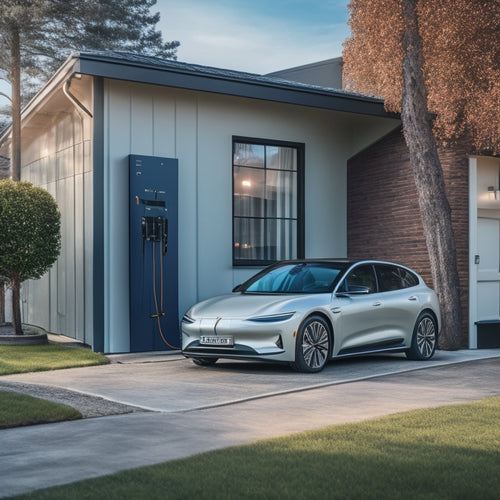
What Determines the Average Cost of Solar Panels and Battery
Share
You pay more for a solar panel and battery system when you need more energy storage, opt for high-efficiency equipment, or live in an area with high labor costs and strong demand. The size and complexity of your system, type and quality of equipment, and installation factors like company reputation and roof conditions all impact the overall cost. Additionally, local market fluctuations, incentives, and financing options can influence the price. As you investigate your solar energy options, understanding these factors will help you make an informed decision - and there's more to evaluate when it comes to getting the best value for your investment.
Key Takeaways
- The size and complexity of the solar panel system, including the number of panels and batteries, significantly impact overall costs.
- The type and quality of equipment, such as panel efficiency ratings and battery durability grades, influence the average cost of solar panels and batteries.
- Installation factors, including the installation company, labor costs, and roof size and material type, affect the final cost of the system.
- Local market dynamics, including demand, competition, and regional pricing variations, contribute to the average cost of solar panels and batteries.
- Incentives and financing options, such as federal tax credits, state rebates, and financing programs, can significantly reduce the average cost of solar panels and batteries.
System Size and Complexity
When sizing up a solar panel and battery system, you're likely to find that the complexity of the setup has a direct impact on the overall cost. The system's size, orientation, and energy needs all play a role in determining the final price tag.
For instance, a larger system with more panels and batteries will naturally cost more than a smaller one. However, the environmental impact of a larger system can be significant, making it a worthwhile investment for those seeking energy independence.
Financing options, maintenance costs, and local regulations also factor into the equation. Technological advancements have made it possible to install systems with advanced features like grid connection, but these come at a higher cost.
Installation timing can also affect the final cost, as seasonal demand and weather conditions can influence labor costs. By understanding these variables, you can make an informed decision about the size and complexity of your solar panel and battery system, ultimately achieving the energy independence you desire while minimizing the financial burden.
Type and Quality of Equipment
You'll find that the type and quality of equipment greatly impact the overall cost of your solar panel and battery system.
Panel efficiency ratings, which range from 15% to 22%, affect how much energy your system can generate.
Meanwhile, battery durability grades, measured in cycle life and depth of discharge, influence how long your system will last and how well it will perform over time.
Panel Efficiency Ratings
Your solar panel system's efficiency hinges on the type and quality of equipment you choose. The panel efficiency rating, measured in percentage, indicates how well your solar panels convert sunlight into electricity. A higher rating means more power output per unit area.
When selecting solar panels, look for high-efficiency models that utilize the latest solar technology advancements. These advancements have led to significant improvements in panel efficiency, with some models boasting ratings above 22%.
Additionally, consider panels with built-in performance monitoring systems, which enable real-time tracking of your system's performance and help identify potential issues.
The efficiency rating also affects the overall cost of your solar panel system. While high-efficiency panels may be more expensive upfront, they can provide more power per unit area, potentially reducing the total number of panels needed and ultimately saving you money.
Battery Durability Grades
Beyond panel efficiency, the type and quality of battery equipment greatly impact the overall performance and lifespan of your solar panel system.
When evaluating battery durability grades, you'll want to take into account factors that affect battery lifespan, such as warranty options, performance degradation, and maintenance requirements. The number of charging cycles a battery can handle also plays a significant role in determining its overall durability. Additionally, temperature sensitivity and usage patterns can influence a battery's performance over time.
You should also take into account the environmental impact of your battery choice, including its recyclability and the brand's reputation for sustainability. A high-quality battery with a long lifespan can reduce waste and minimize its ecological footprint.
Look for batteries with sturdy recycling options to guarantee that your system remains environmentally friendly throughout its entire lifecycle. By carefully evaluating these factors, you can select a battery that meets your needs and provides reliable, long-term performance for your solar panel system.
Installation Company and Labor
When it comes to installing solar panels and batteries, the cost of hiring a professional installation company and their labor can vary greatly depending on several factors, including the company's reputation, skill, and location.
You'll want to take into account the company's installation experience, as a more experienced installer can charge higher rates. Additionally, labor availability in your area can impact the cost, as installers with a high demand may charge more.
Here are some key factors that affect the cost of installation labor:
-
Certifications and credentials: Installers with industry-recognized certifications, such as NABCEP, may charge more for their services.
-
Installation team size and structure: Larger teams with more specialized roles can increase labor costs.
-
Location and travel requirements: Installers who need to travel longer distances or work in remote areas may charge more to account for transportation and accommodation costs.
- Local market conditions: Labor costs can vary depending on the local economy, competition, and demand for solar installations.
Roof Size and Material Type
How does the size and material of your roof impact the cost of solar panels and batteries? The answer lies in the complexity of the installation. A larger roof requires more solar panels, which increases the overall cost. However, a larger roof also means more space to generate electricity, potentially offsetting the higher upfront cost.
The type of roofing material also plays a role. For instance, asphalt shingles are easier to work with than metal or clay tiles, which may require additional labor and materials.
Roof orientation is another vital factor, as a south-facing roof receives more sunlight than a north-facing one, affecting the system's efficiency. Shading issues, such as those caused by trees or nearby buildings, can also impact the system's performance and require additional equipment to mitigate the effects.
When evaluating your roof, consider these factors to determine the most appropriate solar panel and battery system for your needs. A professional installer will evaluate your roof's specific conditions to provide a customized solution that meets your energy goals while keeping costs in check.
Local Market and Competition
The local solar market and competition play a crucial role in determining the cost of solar panels and batteries. As you consider investing in solar energy, it's vital to understand how local factors impact the prices you'll pay.
Several key factors influence the local market and competition:
-
Local demand: High demand for solar panels and batteries in your area can drive up prices, especially if there are few suppliers.
-
Market saturation: If there are many solar panel installation companies in your area, competition may drive prices down.
-
Regional pricing: Prices can vary considerably depending on your location, with urban areas often having lower prices than rural areas.
- Installation trends: The type of installations that are most popular in your area (e.g., residential vs. commercial) can impact prices.
Additionally, competitor strategies, consumer preferences, economic conditions, state regulations, supply chain fluctuations, and weather influences can all affect the cost of solar panels and batteries.
Incentives and Rebate Programs
As you traverse the solar energy market, one crucial aspect to contemplate is the array of incentives and rebate programs designed to encourage the adoption of solar power. These programs can greatly reduce the average cost of solar panels and batteries, making renewable energy more accessible to you.
| Incentive Type | Description |
|---|---|
| Federal Incentives | 30% tax credit for solar panel installation, applicable to residential and commercial properties |
| State Rebates | Varying amounts, typically up to $2.50 per watt, offered by individual states to promote solar adoption |
| Local Grants | Funding opportunities provided by local governments, utilities, or non-profit organizations to support community solar initiatives |
Additionally, you may be eligible for financing options, environmental credits, and utility programs that can further reduce your upfront costs. Some states also offer tax deductions for energy-efficient upgrades, including solar panel installations. By taking advantage of these incentives and rebates, you can enjoy considerable savings and contribute to a more sustainable future.
Battery Type and Capacity
When selecting a battery for your solar panel system, you'll need to evaluate the type of battery chemistry, as it affects the overall performance and lifespan of the battery.
The capacity of the battery, measured in kilowatt-hours (kWh), directly impacts the cost, with higher-capacity batteries requiring a larger upfront investment.
Additionally, you'll want to think about the depth of discharge (DOD), which determines how much of the battery's capacity can be safely used without compromising its longevity.
Battery Chemistry Matters
You're likely aware that not all solar batteries are created equal, and a significant factor driving their performance and cost is the chemistry behind them. The type of battery chemistry you choose can have a significant impact on your solar energy storage system's overall efficiency, lifespan, and environmental footprint.
When it comes to battery chemistry, you have several options to reflect upon. Here are four key factors to keep in mind:
-
Battery Lifespan and Charging Cycles: Different chemistries offer varying lifespans and charging cycles, affecting the overall cost of ownership. Look for chemistries with high cycle life and extended warranties.
-
Energy Density and Thermal Stability: Chemistries like lithium-ion offer high energy density and thermal stability, making them ideal for residential applications. Others, like lead-acid, may be more suitable for commercial or industrial use.
-
Environmental Impact and Safety Standards: Reflect on the environmental impact of the chemistry, as well as adherence to safety standards and regulations. Some chemistries, like nickel-cadmium, have higher environmental concerns.
- Cost Efficiency and Recycling Options: Evaluate the cost efficiency of the chemistry and the availability of recycling options at the end of its life. This can help reduce waste and minimize environmental impact.
Capacity Impacts Cost
Three key factors - battery type, capacity, and brand - greatly influence the cost of your solar energy storage system.
When it comes to capacity, you'll need to evaluate how much energy you want to store and how often you plan to use it. A larger capacity means more energy storage, but it also increases the cost. You'll need to balance your energy needs with your budget.
In capacity planning, you'll want to assess your energy usage patterns and identify the best capacity for your system.
In line with current solar energy trends, it's crucial to choose a capacity that aligns with your energy goals. For instance, if you want to power your home during the night or during a grid outage, you'll need a higher capacity. On the other hand, if you only need to supplement your energy usage during the day, a lower capacity might suffice.
Your capacity decision will greatly impact the overall cost of your solar energy storage system. By carefully evaluating your capacity needs, you can guarantee you get the most value out of your investment.
Depth of Discharge
Beyond capacity, the depth of discharge (DOD) is another critical factor influencing the cost of your solar energy storage system. DOD refers to the percentage of a battery's capacity that's used before recharging. A higher DOD means you're using more of the battery's capacity, which can impact its performance longevity and system reliability.
Here's how DOD affects your energy storage system:
-
Discharge cycles: A higher DOD reduces the number of discharge cycles, increasing the cost of replacement batteries over time.
-
Charge efficiency: A lower DOD helps maintain charge efficiency, reducing energy losses and environmental impact.
-
Usage patterns: Your DOD choice depends on your usage patterns. If you need a lot of energy during the day, a higher DOD might be suitable. However, if you need a steady supply throughout the night, a lower DOD is better.
- Technology advancements: Advances in battery technology have improved DOD, enabling deeper discharge without compromising performance. This has led to more affordable and efficient energy storage solutions.
When selecting a battery, consider your DOD needs carefully, as it greatly impacts your system's overall cost and performance.
Frequently Asked Questions
Do Solar Panels Produce Electricity During Power Outages?
You're wondering if solar panels produce electricity during power outages. The answer is, they don't, unless you have a battery backup system. This is where solar panel efficiency meets power outage solutions, ensuring you stay connected when the grid goes down.
Can I Install Solar Panels on a Rented Property?
You'll need to contemplate rented property considerations and lease agreement implications before installing solar panels; you'll likely require your landlord's permission, and some lease agreements may have restrictions or requirements for alterations to the property.
How Long Does It Take to Install a Solar Panel System?
You're about to reveal the secret to utilizing the sun's power, but first, you're wondering how long it'll take to get there. The installation timeline varies, but you'll typically wait 1-3 months, depending on installation factors like system size, permits, and labor availability.
Are Solar Panels Affected by Pollution and Dirt?
You're right to question if pollution and dirt impact your solar panels. Yes, they do! Dirt and grime can diminish solar efficiency by up to 25%. Regular cleaning is essential; follow maintenance tips like hosing them down during cooler parts of the day to guarantee maximum performance.
Can I Sell Excess Energy to the Utility Company?
Are you tired of watching excess energy go to waste? You can sell it back to the utility company through net metering, benefiting from energy sell-back programs, and offsetting your energy costs, making your solar investment even more worthwhile.
Conclusion
As you weigh the costs of solar panels and batteries, remember that multiple factors come into play. The system size, equipment quality, installation company, roof size, local market, and incentives all influence the final price tag. For instance, a California homeowner who installs a 5kW solar panel system with a 10kWh battery can expect to pay around $25,000. However, with the federal solar investment tax credit, their out-of-pocket cost drops to $18,750, making the switch to renewable energy more accessible and appealing.
Related Posts
-

5 Essential Tips for Buying EV Charging Systems Online
When purchasing an EV charging system online, you'll want to make sure you're making an informed decision. First, det...
-

What You Need to Know About Permits and Inspections
You need to navigate the complex landscape of permits and inspections to guarantee your project complies with local z...
-

Eco-Friendly Car Battery Solutions Available Online
You can now shop online for eco-friendly car battery solutions that not only reduce your carbon footprint but also of...


